Back to page 1
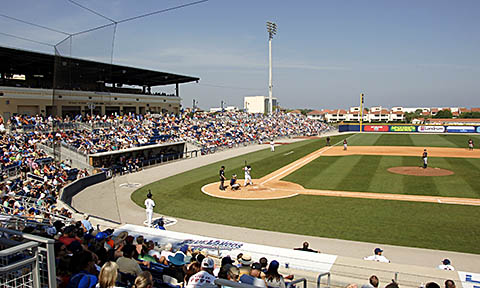 |
| Photo by Gary McCracken, courtesy of the Blue Wahoos |
The Design
Because the original design for Pensacola Multi-Use Stadium was for an indy-league team, certain aspects of the park probably aren’t the way they would’ve been done from scratch for the Double-A Southern League.
“The facility started out as a hub for (economic) development,” Baldwin recalls, “and the Pelicans were going to play in it. So this park was going to be for an independent league team, and there really aren’t (stadium) standards for them.” That means the franchise and the architects were pretty much on their own to do what made sense to them as far as seating capacity, clubhouse size, lighting and so forth were concerned. And work commenced in designing and constructing such a facility.
“About three months after I came on board here, the chance to buy an affiliated team came along, and that introduced many (stadium) standards we had to contend with. We didn’t want to stop and start all over again, but it was almost like stopping and starting all over again,” Baldwin said with a laugh. But having to adhere to the standards for affiliated Minor League facilities wasn’t the only factor that caused the design team to shift gears. “We had to plan for larger crowds, longer lines, accommodating more press, providing a better scoreboard, more office space (and) a better ticketing system.”
Noll said there was another consideration that impacted the layout. “This project isn’t just for baseball,” the architect pointed out. “It was designed for multiple sports (like) football and soccer, and that significantly impacted the seating design.” And, of course, the designers wanted to take advantage of that unbeatable view. “Most seats do face out to the Bay. And the orientation (of the baseball field) is pretty typical, away from the west. In the end, the location of the park and what makes sense for baseball all worked together.”
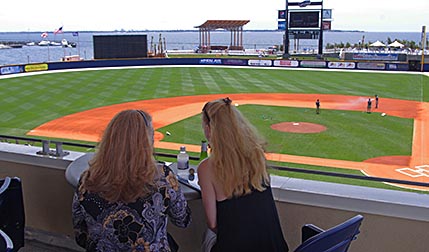 |
Oh, and there were significant budget constraints. Noll pointed out that the original project was to have a pricetag of $14 million, certainly sufficient for an indy team. With all of the additions for the Double-A club, the cost ballooned to $18 million.
For instance, that meant no luxury suites, which are an expensive aspect of most stadiums. “Because we didn’t have money for suites, we came up with the idea of a deck, and that really turned out well,” Baldwin said. That deck is called The Hancock Bank Club, and it rests on the roof on the main structure behind third base. From here, you have perhaps the finest view of the field below and Pensacola Bay beyond (photo above).
 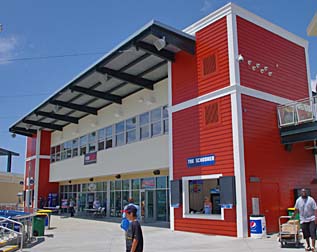 |
On the concourse level of that structure (above left) is the Port Side Grille concession stand (the port side of a boat is the left side — get it?) and the large, well-equipped kitchen behind it. On the ground level is the visitors’ clubhouse and a great deal of storage space. Note that this building has a large metal roof just above the Club deck.
As mentioned previously, the main structure behind home plate (above right) holds — from top to bottom — the pressbox, the souvenir store and Mulroy’s bar, and the team offices. In a ballpark that doesn’t offer much protection from the occasional downpour, the roof that extends out toward the field provides welcome shelter.
The structure behind first base has the Starboard Side Grille (below left) on the concourse and the beautiful home clubhouse and player lounge (below center) on the street level. Note that the “roof” over this building isn’t like the metal roof on the third-base side. That’s because there’s no party deck — or anything else — on the top level here. Architect Noll points out that luxury suites or another party deck can be added here later because “we oversized the structural frame on the first and third base buildings to accommodate possible future suites or a party deck.” The covering over the structure on the first-base side is made up of canopies hooked on cables, “simply to provide sun protection,” Noll explained.
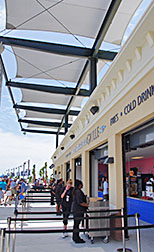 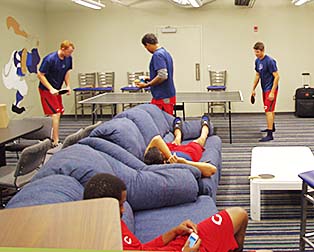  |
Because construction had already started when the need to increase the seating capacity arose, Populous came up with the idea of adding two rows at the back of the seating bowl. So that fans sitting here could see the field easily, those two rows are elevated slightly above the level of the concourse (above right). “There were several things I was dead-set against, but later, I said, ‘oh, yeah, that does work,'” Baldwin admitted. “At one point, I was against the elevated seats on the concourse. Boy, was I wrong.” Indeed, those seats actually seem superior to the rows in front of them. They have kind of an exclusive feel to them, and the vantage point is excellent.
As nice and intimate as the main seating bowl is, the real magic happens down the right-field line. The first area you’ll encounter as you walk away from home plate and toward the Bay is the Margaritaville Tequila Party Deck (below left). Here, the Blue Wahoos tore out bleachers to create this group area with tables and chairs. The view of the field is excellent, but you can’t see the Bay from here.
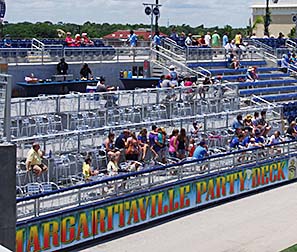 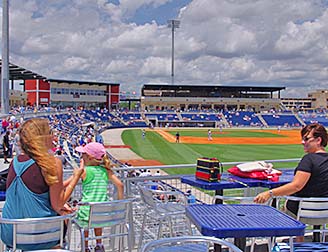 |
As you round the corner near the right-field foul pole, there’s no missing the expansive Bay in front of you. The Coors Light Cold Zone area is here (above right), and this is one of my very favorite spots in the ballpark. Nowhere else can you match this view of the field, the cooling breezes and the proximity to the beautiful Bay.
In fact, the whole section of the concourse that wraps around the foul pole and extends to the batter’s eye in center is a socializing paradise. “I wanted to create a social area,” Baldwin explained. “The place needed to let the fans mingle. Maybe the ballgame isn’t the most important thing to them. It was more important to create an atmosphere where you’re moving around, talking to your friends, while being respectful to the game and to the families there to watch the game. We wanted (this area) to become a destination. I think we did a superb job with that.” Agreed. And the view of the water makes this “destination” even more appealing.
When I asked team owner Quint Studer to tell me his favorite aspect of the park, without hesitation he said, “How the fans can socialize.” And the space is there, from the Coors Light Cold Zone and wide concourse to the popular berm (below left).
Indeed, prior to the Saturday evening game I attended, the right-field area was packed with younger adults, chatting and enjoying themselves immensely. And each paid just $5 to enter the park, the price of a general admission ticket.
 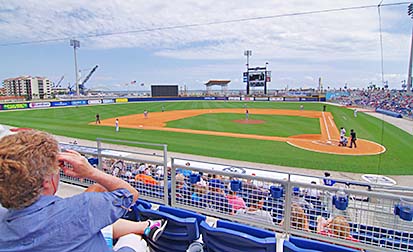 |
| Lefthand photo by Gary McCracken, courtesy of the Blue Wahoos |
Noll thinks that the team and designers hit a home run for the fans in all of the seating areas of the facility, not just in right field. “It’s a perfect size ballpark for Pensacola. You can sit anywhere and have a great view of the field. You’re right there near the action.”
There’s no debating that the fans can enjoy the action on the field, the view of the Bay and the socializing with each other. What about the other aspects of attending a game here?
The Essentials
The fan experience at Blue Wahoo games actually starts long before the gates open. Prior to every game, there is a “staff meeting” with the game-day staff. I watched one of them (below left), and was very impressed. They go over promotions, security concerns, schedules, and most importantly, how to ensure that every fan has a great time.
Indeed, I made special note of the way the staff interacted with me and with fans in general. Every single one of them went out of their way to greet spectators and anyone just wandering down the concourse. They also employed special touches. For instance, the day-game I attended was on Mother’s Day, and as every lady came through the gates, she was handed a carnation (below right).
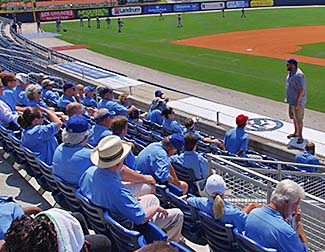 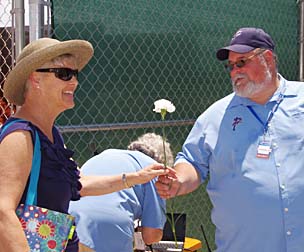 |
We’ve already addressed the fact that there’s little parking adjacent to the new park …. and if you do arrive early enough to snag one of those spaces, it will set you back $10.
A less expensive alternative — one that actually lets you encounter the Pensacola experience — is to park in one of the lots a couple of blocks away in the downtown area. Lots are clearly marked with the price of parking there (usually $5), although there are a number of streets on which you can park for free.
Then ride one of the pedi-cabs or trams to the ballpark. These are free to ride — although you’ll want to tip the driver — and they drop you off right at the box office.
And assuming you don’t see a sign telling you that the game is sold out (a common occurrence in the Blue Wahoos’ inaugural season — see below left), what do they charge you at the ticket windows? A lot less than I would’ve thought.
Frankly, I was very surprised when I saw the ticket prices. In a nice, new park, I expected high prices like at Double-A Frisco. Instead, box seats are $10, reserved seats on aluminum benches with backs are $8 and general admission is only $5. Of course, the Club seats in the first three rows right behind backstop (below right) are a little more ($15) and to sit in the Hancock Bank Club area and eat the great food there is $50, available only to members of that “club.” But for the average fan, the prices are incredibly reasonable.
 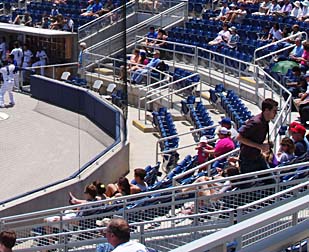 |
Quint Studer told me that their plan was to charge no more than for the independent-league team’s games. “We didn’t want (local) folks saying, ‘Well, now they have their nice, new stadium, so they’re going to charge us an arm and a leg.’ We wanted to keep the prices reasonable.”
“It was important to us to have different price points for our tickets,” Baldwin noted, adding that the $5 GA ticket has been a big, big hit.
The Blue Wahoos even treat their ticket-holders with some extra love. Studer described a program to me that I’d not encountered elsewhere. If a season-ticket holder can’t attend a home game, he can sell his seats through the team’s website, and 80% of the sales price is applied to the next year’s season-ticket bill. “It’s nice for our ticket holders,” he said, “plus it’s a retention strategy of ours to keep our season-ticket base.”
How is the food at the park? It all starts with a cooperative relationship. “We partner with Ovations on the food,” Baldwin explained. “We don’t do a ‘we-they’ thing. We really feel that they are us. We don’t consider them an outside vendor.”
The key, says Baldwin, is that “our food is fresh. Always. One example is our Shrimp PoBoy. We don’t buy cooked shrimp. We get raw shrimp, bread them ourselves and cook them here. We really do take a great deal of pride in the food.”
And that fresh food is really great. In addition to the quality shrimp sandwich ($7), the Blue Wahoos serve an exceptional “Sea Dog” ($7, shown below on the left), a freshly battered and fried cod filet covered with cole slaw. And the bun isn’t a generic hot dog bun. No, this delicacy is on a delicious, soft roll. Just fantastic, and like the shrimp, it’s wonderfully appropriate at this Gulf Coast venue.
The menu isn’t extensive — there are no Greek, Mexican or Italian stands here — but what they do serve is excellent. The regular hot dog ($3) is very good, plus there’s a special burger called The Heater ($8 with fries) that is topped with cheddar cheese, bacon, onion rings and “Wahoo sauce.”
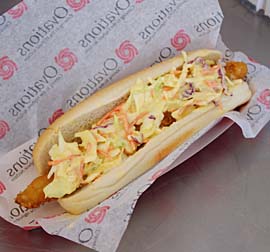  |
Other than the large Port and the Starboard concession areas and beer-only points of sale, there are two other stands — one that caters to kids next to the play area, and the Blue Wahoo Grill (above right). The latter features grilled sausages ($7) and a jumbo hot dog ($6) … although you might forget what you want to order when you spot the Bay beyond the stand!
Speaking of the kids area, the Rainbow International Birthday Galley (below left) is located on the concourse between two of the main buildings. Baldwin indicated to me that this might not be the permanent location for the area devoted to the younger set, but it works well for now. It has tables and chairs that are needed for birthday parties (there were three going on at the same time at one of the games I attended), as well as Kazoo’s Krazy Dogs stand and a moon bounce … and a Dippin’ Dots stand is just a few feet away. Also, because there is an elevated walkway connecting the press box to the Hancock Bank deck, there is covering over the area.
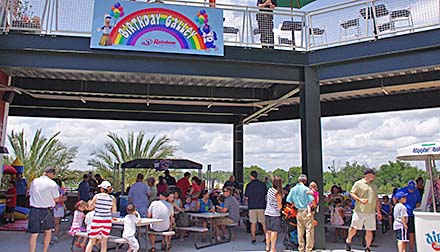 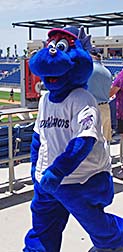 |
Kazoo, by the way, is the furry blue mascot (above right).
In the structure directly behind home plate is the 1,600-square-foot souvenir store (below left), which is certainly large enough for this level of the Minors. There’s no access to the store from the street outside the ballpark, but the team intends to leave the gates open during the offseason, meaning fans will be able to access the shop year-round.
Relative to the price of tickets, the cost of the souvenirs seemed a little high — although the selection is nice for a new team. Most adult T-shirts are $24 or $26. Fitted caps are $33.99, while adjustable ones are $20 (below right). Kids’ T’s are $18 and $20.
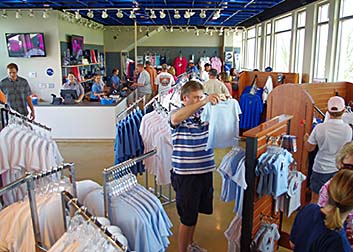  |
The scoreboard in right field is more than adequate. A high-res color video screen sits atop a nice three-line score section. Take special note of the massive supports that hold this scoreboard. Remember that Pensacola virtually sits on the Gulf of Mexico, and hurricanes do occur there. Baldwin told me that the scoreboard structure is built to withstand winds up to 144 mph.
However, if you are in the “socializing” area in right field, you can’t see the scoreboard whatsoever. Maybe that doesn’t matter that much to those fans, but that’s still not right! Baldwin assured me that an auxiliary board will be installed behind home in the coming weeks.
And one final bit of evidence that the Pensacola Blue Wahoos go to great lengths to make fans happy. In the first inning of the Saturday night game I attended, an absolute unending downpour delayed the game for two hours, at which time it was “suspended” to be completed the following day. Well, that night game had been promoted as having fireworks. So as to avoid disappointing the few fans remaining in the park after that long delay, the team announced that the fireworks would be set off anyway — even though it was still pouring!
After seeing dozens and dozens of fireworks shows at ballparks, it was the first time I’d ever seen one in the rain. As lightning sparkled over the Pensacola Bay, the rockets’ red glare lit up the night, reflected in the standing water on the tarp. Quite a scene — one uniquely different than I’d ever seen before.
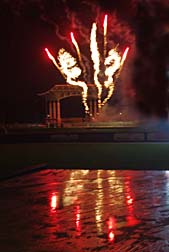 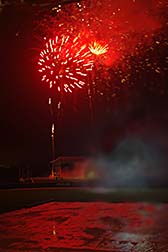 |
With a nod toward the Minor League franchise with a nationwide reputation for delivering an outstanding game-day experience, Baldwin said, “We want to be the best, and not just in Pensacola. We’re getting our sea legs here. In a couple of years, we will battle the Round Rocks toe-to-toe!”
A quick word about the photos with this review: some of the daytime photos show few fans in the stands. That’s because they were taken during the early innings of the continuation of the suspended game, which was about an hour before the scheduled game time for that day. In other words, most fans with tickets for that date didn’t even know that baseball was going to start early. So don’t blame the fan base for the sparse crowd in the photos. They are lovin’ the new team and their beautiful ballpark.
Summary
While Pensacola Bay and some talented architects play key roles in this story, the true stars are Blue Wahoos President Bruce Baldwin (below left) and team co-owners Rishy and Quint Studer (below right).
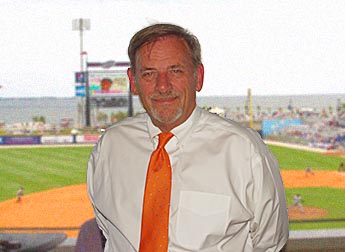  |
A lot of time, energy and money have gone into the Pensacola Multi-Use Stadium, and the resources were well spent when you consider how beautifully everything turned out, including earning the high honor of being named our Ballpark of the Year. But this kind of success doesn’t happen without an unwavering commitment to quality and a solid gameplan.
“We looked at it in three separate ‘community pots,’ if you will,” Baldwin said in explaining the underlying strategy to make the new team and ballpark a success — and to spur local economic growth. “First, we looked at the team and facility requirements. Second, there are the amenities to provide to the fans. Third was the economic development. Our focus was always on how to marry the three together. How do we connect the stadium with economic opportunity in our community? I’ve always preached that it’s not about baseball at all. The sport is the catalyst for future growth. Pensacola is in the embryonic stages of embracing that.”
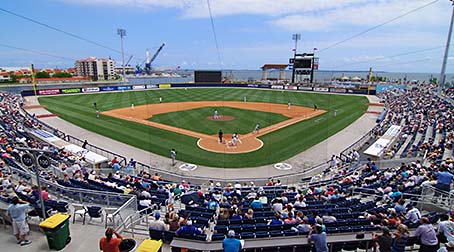 |
And with a uniquely different ballpark — one on the short list of having the best view in all of sports — as a blueprint for progress and additional financial development, the future is incredibly bright in Pensacola.